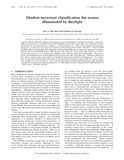| dc.contributor.author | Marchant, John A. | |
| dc.contributor.author | Onyango, Christine M. | |
| dc.date.accessioned | 2013-06-18T06:15:02Z | |
| dc.date.available | 2013-06-18T06:15:02Z | |
| dc.date.issued | 2000 | |
| dc.identifier.citation | Optics InfoBase > JOSA A > Volume 17 > Issue 11 | en |
| dc.identifier.uri | //dx.doi.org/10.1364/JOSAA.17.001952 | |
| dc.identifier.uri | http://erepository.uonbi.ac.ke:8080/xmlui/handle/123456789/35230 | |
| dc.description.abstract | A physics-based method for shadow compensation in scenes illuminated by daylight is proposed. If the daylight is represented by a simplified form of the blackbody law and the camera filters are of infinitely narrow bandwidth, the relationship between red/blue (rm) and green/blue (gm) ratios as the blackbody’s temperature changes is a simple power law where the exponent is independent of the surface reflectivity. When the CIE daylight model is used instead of the blackbody and finite bandwidths for the camera are assumed, it is shown that the power law still holds with a slight change to the exponent. This means that images can be transformed into a map of rm/gmA and then thresholded to yield a shadow-independent classification. Exponent A can be precalculated from the CIE daylight model and the camera filter characteristics. Results are shown for four outdoor images that contain sunny and shadowed parts with vegetation and background. It is shown that the gray-level distributions of the pixels in the transformed images are quite similar for a given component whether or not it is in shadow. The transformation leads to bimodal histograms from which thresholds can easily be selected to give good classifications. | en |
| dc.language.iso | en | en |
| dc.publisher | Univesity of Nairobi | en |
| dc.title | Shadow-invariant classification for scenes illuminated by daylight | en |
| dc.type | Article | en |
| local.publisher | Department of plant science and crop protection | en |


